Refine search
Actions for selected content:
213 results
Chapter 3 - Socialist Competition
-
-
- Book:
- Questioning Conventional Assumptions of Competition Dynamics
- Published online:
- 07 May 2025
- Print publication:
- 21 August 2025, pp 58-97
-
- Chapter
- Export citation
Introduction
-
-
- Book:
- Antifascism(s) in Latin America and the Caribbean
- Published online:
- 21 July 2025
- Print publication:
- 07 August 2025, pp 1-22
-
- Chapter
- Export citation
Lightning-Sword and Blazing Steed under the Hammer and Sickle: The Rebirth of David of Sassoun in Soviet Armenia
-
- Journal:
- Nationalities Papers , FirstView
- Published online by Cambridge University Press:
- 30 July 2025, pp. 1-27
-
- Article
-
- You have access
- Open access
- HTML
- Export citation
Chapter 30 - The Central European Stage
- from Part IV - Performance Legacies
-
-
- Book:
- Sean O'Casey in Context
- Published online:
- 23 June 2025
- Print publication:
- 10 July 2025, pp 329-339
-
- Chapter
- Export citation
Chapter 18 - Bernard Shaw
- from Part III - Collaborators and Critics
-
-
- Book:
- Sean O'Casey in Context
- Published online:
- 23 June 2025
- Print publication:
- 10 July 2025, pp 192-201
-
- Chapter
- Export citation
Chapter 7 - Class
- from Part II - Social Contexts
-
-
- Book:
- Sean O'Casey in Context
- Published online:
- 23 June 2025
- Print publication:
- 10 July 2025, pp 79-88
-
- Chapter
- Export citation
Chapter 4 - The Second World War
- from Part I - Key Places and Events
-
-
- Book:
- Sean O'Casey in Context
- Published online:
- 23 June 2025
- Print publication:
- 10 July 2025, pp 45-56
-
- Chapter
- Export citation
6 - The Institutional Genes of Totalitarian Ideology
-
- Book:
- Institutional Genes
- Published online:
- 03 June 2025
- Print publication:
- 26 June 2025, pp 202-260
-
- Chapter
- Export citation
13 - Communism and Anticommunism
-
-
- Book:
- The Cambridge History of the Holocaust
- Published online:
- 16 May 2025
- Print publication:
- 12 June 2025, pp 268-287
-
- Chapter
- Export citation

Institutional Genes
- Origins of China's Institutions and Totalitarianism
-
- Published online:
- 03 June 2025
- Print publication:
- 26 June 2025
Chapter 8 - Actualizing Philosophy
-
- Book:
- Karl Marx and the Actualization of Philosophy
- Published online:
- 17 April 2025
- Print publication:
- 24 April 2025, pp 169-181
-
- Chapter
- Export citation
Chapter 4 - Humanism and Naturalism in the Paris Manuscripts
-
- Book:
- Karl Marx and the Actualization of Philosophy
- Published online:
- 17 April 2025
- Print publication:
- 24 April 2025, pp 82-105
-
- Chapter
- Export citation

Karl Marx and the Actualization of Philosophy
-
- Published online:
- 17 April 2025
- Print publication:
- 24 April 2025
3 - The Rise and Fall of the Great Changemakers
-
- Book:
- The Greatest of All Time
- Published online:
- 23 January 2025
- Print publication:
- 06 March 2025, pp 81-121
-
- Chapter
- Export citation
Chapter 9 - From Socialist to Democratic Planning in Context
-
- Book:
- Otto Neurath in Britain
- Published online:
- 09 January 2025
- Print publication:
- 23 January 2025, pp 232-265
-
- Chapter
- Export citation
Chapter 4 - Becoming ‘British Furniture’
-
- Book:
- Otto Neurath in Britain
- Published online:
- 09 January 2025
- Print publication:
- 23 January 2025, pp 97-128
-
- Chapter
- Export citation
3 - The Rise and Fall of Totalitarianism
-
- Book:
- Constitutional Reforms in China
- Published online:
- 19 December 2024
- Print publication:
- 02 January 2025, pp 83-129
-
- Chapter
- Export citation
The two grand movements of socialism and their dialectics: A global Retrospect – CORRIGENDUM
-
- Journal:
- International Labor and Working-Class History / Volume 106 / October 2024
- Published online by Cambridge University Press:
- 23 December 2024, p. 476
-
- Article
-
- You have access
- Open access
- HTML
- Export citation
Chapter 6 - Interpretation
-
- Book:
- The Quislings
- Published online:
- 12 December 2024
- Print publication:
- 19 December 2024, pp 226-256
-
- Chapter
- Export citation
6 - Hanoi’s Politburo at War, 1969–1975
- from Part I - The Late Vietnam War
-
-
- Book:
- The Cambridge History of the Vietnam War
- Published online:
- 02 January 2025
- Print publication:
- 28 November 2024, pp 141-162
-
- Chapter
- Export citation
